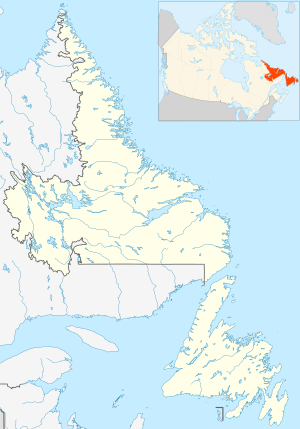
Summary
Spotted Island Air Station (ADC ID: N-27B) was a General Surveillance Gap Filler Radar station in the Canadian province of Newfoundland and Labrador, It was located 195 miles (314 km) east of CFB Goose Bay.[1] It was closed in 1961.
Spotted Island Air Station | |
|---|---|
| Part of Pinetree Line | |
| Labrador, Canada | |
 Emblem of the 922d Aircraft Control and Warning Squadron | |
| Coordinates | 53°31′05″N 055°44′56″W / 53.51806°N 55.74889°W |
| Type | Radar Station |
| Code | N-27B |
| Site information | |
| Controlled by | Aerospace Defense Command |
| Site history | |
| Built | 1957 |
| Built by | United States Air Force |
| In use | 1957-1961 |

History edit
The site was established in 1957 as a staffed Gap Filler radar station, built by the United States Air Force, under operational control of Cartwright Air Station and part of the Pinetree Line of Ground-Control Intercept (GCI) radar sites.
The station was assigned to Aerospace Defense Command in 1957, and was given designation "N-27B". Aerospace Defense Command stationed the 922d Aircraft Control and Warning Squadron at the station in 1957. It operated an AN/FPS-14 staffed Gap Filler search radar.[2]
USAF units and assignments edit
Units:
- 922d Aircraft Control and Warning Squadron, Activated at Grenier AFB, New Hampshire 26 May 1953
- Moved to Cartwright Air Station, 1 October 1953
- Discontinued 1961[3]
Assignments:
- 4732d Air Defense Group (ADC), 1 April 1957
- Goose Air Defense Sector, 1 April 1960
See also edit
References edit
This article incorporates public domain material from the Air Force Historical Research Agency
- A Handbook of Aerospace Defense Organization 1946 - 1980, by Lloyd H. Cornett and Mildred W. Johnson, Office of History, Aerospace Defense Center, Peterson Air Force Base, Colorado
- Winkler, David F. (1997), Searching the skies: the legacy of the United States Cold War defense radar program. Prepared for United States Air Force Headquarters Air Combat Command.


